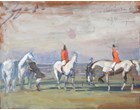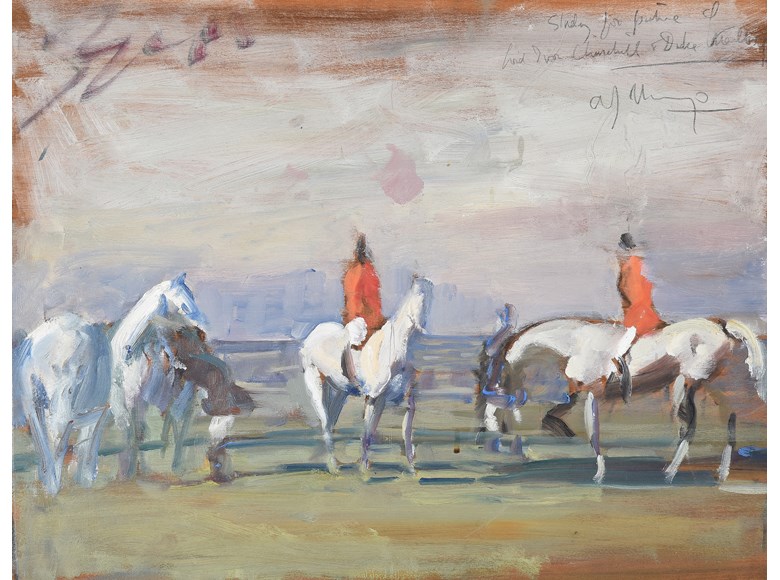 BACK TO GALLERY
BACK TO GALLERY
Rountree Tryon Galleries
Sir Alfred James Munnings
Four Grey Horses: Studies of The 9th Duke of Marlborough and Lord Ivor Spencer-Churchill
11½ x 15¾ in. (29.5 x 40.5 cm)
description
FSir Alfred James Munnings, P.R.A., R.W.S. (1878-1959)
Four Grey Horses: Studies of The 9th Duke of Marlborough and Lord Ivor Spencer-Churchill
oil on panel
signed and inscribed 'Study for picture of/Lord Ivor Churchill & Duke of Marlborough/a j Munnings.' (upper right); the reverse signed 'a j Munnings' (lower left), and inscribed and dated 'Studies for/Lord Ivor Churchill/R.A. 1923 - ' (centre left)
11½ x 15¾ in. (29.5 x 40.5 cm)
Provenance:
Acquired directly from the artist by Sir Jack Jarvis;
Thence by descent.
This double-sided panel of sketches in oil features studies for one of Munnings’ most important commissions in the 1920s - The Duke of Marlborough and Lord Ivor Spencer-Churchill. The painting, which depicts the Duke and his son changing horses whilst out hunting, was exhibited at the Royal Academy in 1924 and remains today in the Spencer-Churchill collection at Blenheim Palace.
Munnings describes the commission extensively in the second volume of his memoirs (A.J. Munnings, The Second Burst, Bungay, 1951, pp. 155-6), recounting how plans were set in motion during a dinner with the Duke at The Other Club.
'He [the Duke] launched into the subject of traditional composition: a hunting picture of himself and Lord Ivor Churchill on horseback, on grey horses - Lord Ivor had already suggested the picture to me. "A signpost to Melton was the thing," said the Duke; "we must have a signpost in it! Changing horses, four greys, with the second horseman in full rig; what a subject! Mind you put me on the best horse."'
The account continues to describe how both the Duke and Lord Ivor came for sittings at his London studio at Glebe Place, while he painted the grooms and horses at Blenheim. He prepared meticulously for portraits, making preparatory sketches to get to know a subject, and the present studies represent part of this process for the commission.
The first side of the panel is a compositional study, which is especially intriguing in light of Munnings’ conversation with the Duke about composition referenced above and may well be the original concept. It closely resembles the beautifully balanced assembly of the finished work – Lord Ivor on the grey horse on the right having its curb-chain adjusted by a second horseman, the Duke in the centre, and on the left, another second horseman holding the two greys from which father and son have just dismounted. There is a wonderful confidence and immediacy to the mark making and we can see Munnings developing his palette and exploring the effects of light with subtle tones and dashes of blue, purple and yellow.
The other side of the panel provides a different perspective, with three intricate workings of Lord Ivor on his horse in hunting pinks and top hat. Munnings tries out different positions for his head and arms against light and dark backgrounds, combining a soft and delicate handling of the faces with more expressive strokes elsewhere. This was presumably executed from life during the sitter’s visit to Munnings’ studio.
Several other preparatory works relating to the commission have appeared on the market, including four panels of the same size as the present work which all sold for between $156,000 and $296,000 at Christie’s New York on 1st December 2006 (lots 62-65). These panels had passed by descent through the Spencer-Churchill family whereas this work was purchased directly from Munnings by renowned racehorse trainer Sir Jack Jarvis (1887-1968), before being passed by descent. Jarvis trained nine British Classic winners and in 1967 became the first trainer to be knighted for services to racing.
Charles Richard John Spencer-Churchill, 9th Duke of Marlborough (1871-1934) succeeded his father in 1892 and famously married prominent American socialite Consuelo Vanderbilt at Blenheim Palace in 1895. They had two children together – John Spencer-Churchill, 10th Duke of Marlborough (1897-1972) and Lord Ivor Spencer-Churchill (1898-1956).
This work has been specially framed making it possible to easily switch between displaying either side of the panel.
Four Grey Horses: Studies of The 9th Duke of Marlborough and Lord Ivor Spencer-Churchill
oil on panel
signed and inscribed 'Study for picture of/Lord Ivor Churchill & Duke of Marlborough/a j Munnings.' (upper right); the reverse signed 'a j Munnings' (lower left), and inscribed and dated 'Studies for/Lord Ivor Churchill/R.A. 1923 - ' (centre left)
11½ x 15¾ in. (29.5 x 40.5 cm)
Provenance:
Acquired directly from the artist by Sir Jack Jarvis;
Thence by descent.
This double-sided panel of sketches in oil features studies for one of Munnings’ most important commissions in the 1920s - The Duke of Marlborough and Lord Ivor Spencer-Churchill. The painting, which depicts the Duke and his son changing horses whilst out hunting, was exhibited at the Royal Academy in 1924 and remains today in the Spencer-Churchill collection at Blenheim Palace.
Munnings describes the commission extensively in the second volume of his memoirs (A.J. Munnings, The Second Burst, Bungay, 1951, pp. 155-6), recounting how plans were set in motion during a dinner with the Duke at The Other Club.
'He [the Duke] launched into the subject of traditional composition: a hunting picture of himself and Lord Ivor Churchill on horseback, on grey horses - Lord Ivor had already suggested the picture to me. "A signpost to Melton was the thing," said the Duke; "we must have a signpost in it! Changing horses, four greys, with the second horseman in full rig; what a subject! Mind you put me on the best horse."'
The account continues to describe how both the Duke and Lord Ivor came for sittings at his London studio at Glebe Place, while he painted the grooms and horses at Blenheim. He prepared meticulously for portraits, making preparatory sketches to get to know a subject, and the present studies represent part of this process for the commission.
The first side of the panel is a compositional study, which is especially intriguing in light of Munnings’ conversation with the Duke about composition referenced above and may well be the original concept. It closely resembles the beautifully balanced assembly of the finished work – Lord Ivor on the grey horse on the right having its curb-chain adjusted by a second horseman, the Duke in the centre, and on the left, another second horseman holding the two greys from which father and son have just dismounted. There is a wonderful confidence and immediacy to the mark making and we can see Munnings developing his palette and exploring the effects of light with subtle tones and dashes of blue, purple and yellow.
The other side of the panel provides a different perspective, with three intricate workings of Lord Ivor on his horse in hunting pinks and top hat. Munnings tries out different positions for his head and arms against light and dark backgrounds, combining a soft and delicate handling of the faces with more expressive strokes elsewhere. This was presumably executed from life during the sitter’s visit to Munnings’ studio.
Several other preparatory works relating to the commission have appeared on the market, including four panels of the same size as the present work which all sold for between $156,000 and $296,000 at Christie’s New York on 1st December 2006 (lots 62-65). These panels had passed by descent through the Spencer-Churchill family whereas this work was purchased directly from Munnings by renowned racehorse trainer Sir Jack Jarvis (1887-1968), before being passed by descent. Jarvis trained nine British Classic winners and in 1967 became the first trainer to be knighted for services to racing.
Charles Richard John Spencer-Churchill, 9th Duke of Marlborough (1871-1934) succeeded his father in 1892 and famously married prominent American socialite Consuelo Vanderbilt at Blenheim Palace in 1895. They had two children together – John Spencer-Churchill, 10th Duke of Marlborough (1897-1972) and Lord Ivor Spencer-Churchill (1898-1956).
This work has been specially framed making it possible to easily switch between displaying either side of the panel.








 SEND AN EMAIL
SEND AN EMAIL
 +441798344207
+441798344207